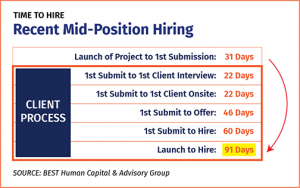Effective Strategies for Hiring in the Horticulture Industry
By Benjamin Molenda & Harrison Downing, Human Capital Advisors at BEST Human Capital & Advisory Group
Are you excited at the prospect of increased demand in the Horticulture Industry over the next few years? But, on the other hand, are you concerned that you will struggle to supply material to meet consumer demand? You are not alone in these thought processes. Most companies are identifying areas to invest increased revenue in satisfying new requirements. Whether through R&D, new market channels, LEAN manufacturing approaches, supply chain amelioration, or bringing on talent for these and additional departments. When hiring in today’s changing climate, it is important to understand options, strategize a plan, and develop expectations, as the industry’s talent pool is critically thin compared to talent needs.
The Process
Scheduling interviews can be complicated, especially acknowledging that not only are your team members busy with their responsibilities, but the prospective candidate is likely busy in their current role. The chances of finding a quality applicant who is currently unemployed are slim. Thus, it is imperative to be realistic when setting a start date for a new hire. The traditional “2 weeks’ notice” is often satisfactory. However, occasionally, more time is required for the individual to leave their previous employer, potentially your same customers, and put them in a position for success. None of us want to burn any bridges.
It is now a commonly accepted, if not begrudged, belief that quality professionals are not frequenting job boards and applying to postings. In discussions with many companies, posting a job is often more about marketing than actually identifying candidates. Utilizing current relationships to network opportunities, involving HR teams and other departments to brainstorm candidate flow, and inquiring with customers or suppliers on star players they interact with are among the options to identify talent in our close-knit industry.
 The graphic at right represents a recent mid-level position hire. The hiring project timeline included posting job descriptions on job boards, networking with industry leaders, and actively sourcing candidates through executive search. At a minimum, it typically takes (3) weeks to identify qualified individuals, (3) weeks to interview and offer, and (3) weeks for the individual to transition and start in their new role. For senior-level positions, plan to add a minimum of (2) weeks for each of the three steps. Because of this dynamic and the budgeting process, many companies start their hiring process a year in advance to identify what roles are needed in their organization.
The graphic at right represents a recent mid-level position hire. The hiring project timeline included posting job descriptions on job boards, networking with industry leaders, and actively sourcing candidates through executive search. At a minimum, it typically takes (3) weeks to identify qualified individuals, (3) weeks to interview and offer, and (3) weeks for the individual to transition and start in their new role. For senior-level positions, plan to add a minimum of (2) weeks for each of the three steps. Because of this dynamic and the budgeting process, many companies start their hiring process a year in advance to identify what roles are needed in their organization.
Hiring from within is a practical approach as it is quick, cost-effective, fluid with the company culture, and can motivate loyal employees who aspire to grow professionally. These items add up to expose less risk than hiring externally. However, internal promotion is not always the best option. Animosity between internal applicants can arise, leading team members not chosen to question loyalty. Another critical element to hiring from within is succession planning. As one hole is filled, another is created in the previous position. Active cross-training prepares team members for succession, strengthens the organizational chart, and motivates the team. Finally, from a legal and efficacy standpoint, a hybrid approach of external search and looking within ensures all available talent is vetted as there is a lack of candidates in our industry.
Positions in Operations, R&D, Supply Chain, eCommerce, Analytics, and Sales are being created as companies match changing markets with innovation. Yet, retirement rates are increasing, reducing what is already a thin talent pool for horticulture. Add to this that CEA, Cannabis, and Hemp are hiring from the same talent pool as Ornamental, Nursery, Landscaping, Turf, and Greenhouse – there is indeed a growing talent gap.
 Casting a broad and flexible net when sourcing talent is crucial. One strategy includes considering all candidates, regardless of age. Another is compromising the amount of required product knowledge, customer relationships, or years of experience and instead focusing on a professional’s behaviors. This option requires increased front-end work through strategic planning and assessments. However, it will ultimately unlock a lucrative talent pool, allow for culture alignment, and increase productivity based on the candidate’s behaviors. We should not ignore experience and product knowledge. Painting a “purple squirrel” (what we call a perfect candidate) is an important thought project when conceptualizing a position, but how many purple squirrels have you seen? If there are (5) “boxes” that you believe must be checked for a role, it may be worth reducing it to a top (3). If a candidate shows strong behaviors, perhaps they can achieve the (2) boxes they cannot check with proper training and management. Conversely, it is nearly impossible to train or manage behaviors as they are set early in life. Behavior-based hiring dramatically opens the talent pool outside of the industry for the right fit.
Casting a broad and flexible net when sourcing talent is crucial. One strategy includes considering all candidates, regardless of age. Another is compromising the amount of required product knowledge, customer relationships, or years of experience and instead focusing on a professional’s behaviors. This option requires increased front-end work through strategic planning and assessments. However, it will ultimately unlock a lucrative talent pool, allow for culture alignment, and increase productivity based on the candidate’s behaviors. We should not ignore experience and product knowledge. Painting a “purple squirrel” (what we call a perfect candidate) is an important thought project when conceptualizing a position, but how many purple squirrels have you seen? If there are (5) “boxes” that you believe must be checked for a role, it may be worth reducing it to a top (3). If a candidate shows strong behaviors, perhaps they can achieve the (2) boxes they cannot check with proper training and management. Conversely, it is nearly impossible to train or manage behaviors as they are set early in life. Behavior-based hiring dramatically opens the talent pool outside of the industry for the right fit.
There will be repetitive conversations in interviews, but developing separate focus areas for each interviewer is integral to moving quickly. This approach also gives the prospect an understanding of potential interactions with the interviewer. Continuing to utilize virtual meeting resources early in the interview process allows for flexibility. One-on-one interviews with senior leaders are expected, but interview teams of 2-3 display company culture for the candidate and expedite the process.
Once in interviews, an element to consider is how the candidate will be led based on their personality and responsibilities. The initial conversation with a candidate may be the most important. Spend it listening and learning. Listen 80% of the time and speak 20% of the time. Engage them about experiences, listen to what motivates them professionally, and focus on behaviors illustrated when describing achievements. Do not oversell the position or company as there is no perfect job or company. Accentuate the positives but be transparent about challenges and difficulties in the role. Truly understanding your prospect’s personality traits and professional behaviors will create a stronger relationship leading to higher buy-in, more productivity, and continued transparency.
Congratulations, you have hired a strong professional! However, the process of engaging them is just beginning. A critical component is a thorough, 90-day onboard program that assimilates them into the role and company culture, one step at a time. Companies who utilize these comprehensive onboarding schedules have substantially higher retention rates and productivity from the position year one.
Ben Molenda and Harrison Downing are Human Capital Advisors with BEST Human Capital & Advisory Group specializing in retained recruiting within the horticultural industry.





